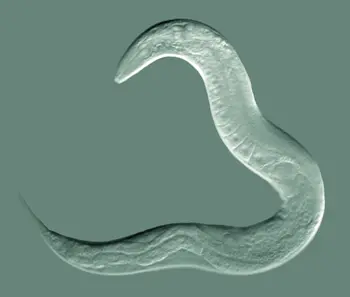[Originally published as Nematode Nervous System: A 1-in-40-Million Design]
I have been doing an “interstate book club” with one of the most brilliant people I know. She and I read the same book and call each other on a regular basis to discuss it. We are currently covering Jerry Fodor and Massimo Piatelli-Palmarini’s book, What Darwin Got Wrong, and I ran across something that I found so amazing, I had to write about it today. It has to do with the roundworm known as Caenorhabditis elegans, which is pictured above. This tiny (about 1 millimeter long), transparent worm has been studied extensively. In fact, it was the first multicellular organism to have its genome fully sequenced.1
 Before that happened, however, Christopher Cherniak did a detailed analysis of the creature’s nervous system.
Before that happened, however, Christopher Cherniak did a detailed analysis of the creature’s nervous system.
Approximately one-third of the cells in the roundworm’s body are nerve cells, so the nervous system is obviously important to this tiny animal. The system is made of clumps of nerve cells (called ganglia) in the head, tail, and scattered throughout the main nerve cord, which runs along the bottom of the worm’s body.
While this system is “simple” compared to the kind of nervous systems you find in many other animals, it has served as a model for helping scientists understand how nervous systems develop and function in general.
Of course, since the nervous system has to process sensory information and control various muscle movements, the ganglia must be connected to one another, to the receptors that sense the outside world, and to the muscles that the nervous system controls. Obviously, then, there is a lot of “wiring” involved.
Cherniak wanted to know what determined how this wiring was done in the animal, so he computed all the possible ways that the worm’s nervous system could be wired, given its structure and the number of components it had. His computation indicated that there were 39,916,800 ways the wiring could have been done.
Now that’s a lot of possibilities, but even back in 1994, computers could easily analyze all of them, so he used 11 microcomputers to analyze all 39,916,800 ways the nervous system could be wired. It took them a total of 50 hours to churn through the analysis, but what they found was incredible!
In comparing the different means by which the nervous system could be wired, they found that there was a big difference in the amount of wiring used. Some layouts were very efficient in how they used the wiring, and others were very inefficient. How did the real nervous system layout compare? Here is what Cherniak wrote:2
The actual ganglion order in fact appears to be the unique optimal one out of these millions for minimizing total interconnecting fiber length.
In other words, out of the nearly 40 million possibilities, the roundworm just happens to have the layout that requires the least amount of material!
Why is this important? Because it argues strongly against the neo-Darwinian view that random mutation acted on by natural selection is what determines such things. What’s the chance that random mutation would produce the most optimum design out of a possible 40 million?
After all, it took 11 microcomputers (using 1994 technology) a total of 50 hours to analyze the layouts and determine the most optimum design, and they were programmed specifically for that purpose. Is it really possible that through the history of roundworm evolution, random mutation could “offer up” to natural selection the unique, best solution?
Of course, if this were the only example of such optimization, perhaps you could believe that the roundworm just got lucky. Random mutation did just happen on the most optimum layout for its nervous system. However, Fodor and Piatelli-Palmarini spend 12 pages cataloging many more examples of optimum design in living organisms.
Now, of course, they don’t like to use the term “design,” because they are both atheists and don’t want to refer to any kind of Designer in their analysis. Instead, they want to believe that there are nonrandom forces at work that limit the ways in which organisms can evolve.
To me, however, the reason for the nematode’s optimal nervous system is clear: it was designed by God. As a result, you would expect the design to be elegant and efficient. Thus, the fact that it is optimized to use the least amount of material is not surprising. The same could be said of the other examples covered in the 12 pages I mentioned above.
In the end, the creationist view expects a myriad of optimal designs in nature, and that’s precisely what you find. Now, of course, there are some designs that don’t appear to be optimal, but they are few and far between. In addition, some designs that initially appear suboptimal end up being pronounced optimal based on additional research. The over-arching principle in nature seems to be that of optimal design. While evolutionists might be able to eventually find some explanation around this fact, Fodor and Massimo Piatelli-Palmarini clearly show that they haven’t been able to do so yet.
In the creationist view, there is no need to explain around things like the layout of the nematode’s nervous system. It is exactly what you would expect from a creation made by the Almighty.
References
- The C. elegans Sequencing Consortium, Consortium, “Genome sequence of the nematode C. elegans: a platform for investigating biology,” Science 282: 2012–2018, 1998.
- Christopher Cherniak, “Component Placement Optimization in the Brain,” The Journal of Neuroscience 14(4):2418-2427, 1994.







